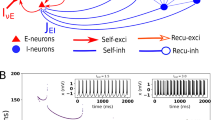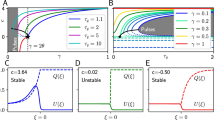Abstract
An experiment using a multisensor SQUID (superconducting quantum interference device) array was performed by Kelso and colleagues (1992) which combined information from three different sources: perception, motor response, and brain signals. When an acoustic stimulus frequency is changed systematically, a spontaneous transition in coordination occurs at a critical frequency in both motor behavior and brain signals. Qualitatively analogous transitions are known for physical and biological systems such as changes in the coordination of human hand movements (Kelso 1981, 1984). In this paper we develop a theoretical model based on methods from the interdisciplinary field of synergetics (Haken 1983, 1987) and nonlinear oscillator theory that reproduces the main experimental features very well and suggests a formulation of a fundamental biophysical coupling.
Similar content being viewed by others
References
Arnol'd VI (1980) Gewöhnliche Differentialgleichungen. Springer, Berlin Heidelberg New York
Friedrich R, Fuchs A, Haken H (1992) Spatio temporal EEG patterns. In: Haken H, Koepchen HP (eds) Rhythms in physiological systems. Springer, Berlin Heidelberg New York
Fuchs A, Kelso JAS, Haken H (1992) Phase transitions in the human brain: spatial mode dynamics. Int J Bifurcation Chaos 2:917–939
Fuchs A, Friedrich R, Haken H, Lehman D (1987) Spatio temporal analysis of multichannel α-EEG map series. In: Haken H (ed) Computational systems natural and artificial. Springer, Berlin Heidelberg New York
Haken H (1983) Synergetics. An introduction, 3rd edn. Springer, Berlin Heidelberg New York
Haken H (1987) Advanced synergetics, 2nd edn. Springer, Berlin Heidelberg New York
Haken H (1988) Information and self-organization. Springer, Berlin Heidelberg New York
Haken H, Kelso JAS, Bunz H (1985) A theoretical model of phase transitions in human hand movements. Biol Cybern 51:347–356
Kelso JAS (1981) On the oscillatory basis of movement. Bull Psychonomic Soc 18:63
Kelso JAS (1984) Phase transitions and critical behavior in human bimanual coordination. Am J Physiol 15:R1000-R1004
Keiso JAS, Bressler SL, Buchanan S, DeGuzman GC, Ding M, Fuchs A, Holroyd T (1992) A phase transition in human brain and behavior. Phys Lett A 169:134–144
McLachlan NW (1947) Theory and application of Mathieu functions. Oxford University Press, London
Schöner G, Yiang WY, Kelso JAS (1990) A synergetic theory of quadrupedal gaits and gait transitions. Theor Biol 142:359–391
Shik ML, Severin FV, Orlovskii GN (1966) Control of walking and running by means of electrical stimulation of the mid-brain. Biofizyka 11:659–666
Yakubovich VA, Starzhinskii VM (1975) Linear differential equations with periodic coefficients, Vols 1 and 2. Wiley, New York
Author information
Authors and Affiliations
Rights and permissions
About this article
Cite this article
Jirsa, V.K., Friedrich, R., Haken, H. et al. A theoretical model of phase transitions in the human brain. Biol. Cybern. 71, 27–35 (1994). https://doi.org/10.1007/BF00198909
Received:
Issue Date:
DOI: https://doi.org/10.1007/BF00198909




